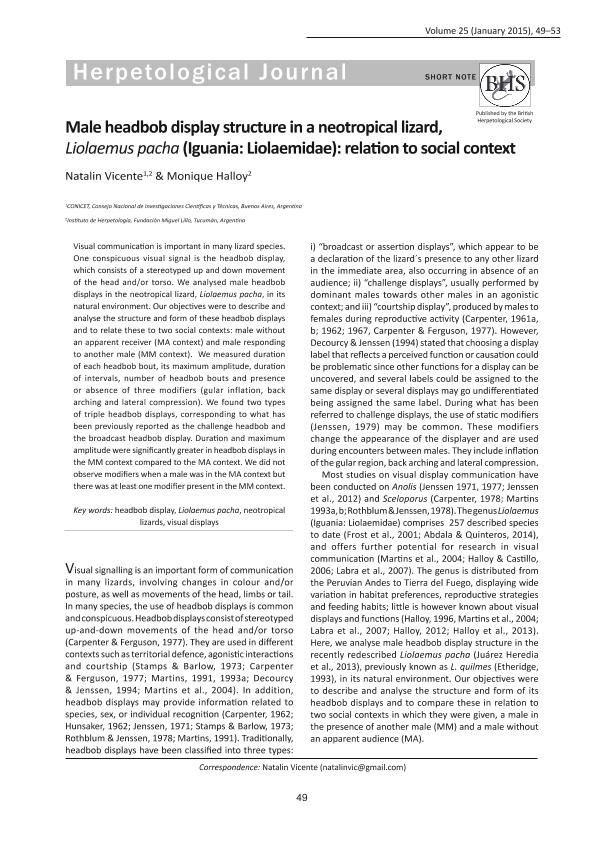Mostrar el registro sencillo del ítem
dc.contributor.author
Vicente, Natalin Soledad

dc.contributor.author
Halloy, Monique

dc.date.available
2021-10-01T14:43:43Z
dc.date.issued
2015-02
dc.identifier.citation
Vicente, Natalin Soledad; Halloy, Monique; Male headbob display structure in a neotropical lizard, Liolaemus pacha (Iguania: Liolaemidae): relation to social context; British Herpetological Society; Herpetological Journal; 25; 1; 2-2015; 49-53
dc.identifier.issn
0268-0130
dc.identifier.uri
http://hdl.handle.net/11336/142235
dc.description.abstract
Visual communication is important in many lizard species. One conspicuous visual signal is the headbob display, which consists in a stereotyped up and down movement of the head and/or torso. We analysed male headbob displays in the neotropical lizard, Liolaemus pacha, in its natural environment. Our objectives were to describe and analyse the structure and form of these headbob displays and to relate these to two social contexts: male without an apparent receiver (MA context) and male responding to another male (MM context). We calculated duration of each headbob bout, its maximum amplitude, duration of intervals, number of headbob bouts and presence or absence of three modifiers (gular inflation, back arching and lateral compression). We performed linear mixed-effects models (LMMs) to compare maximum amplitude and duration of headbob bouts and intervals between contexts. To compare the number of headbob bouts per headbob display between contexts, we conducted a Mann-Whitney test. We found two types of headbob displays, both characterized by triple headbob bouts. We found that duration and maximum amplitude were significantly greater in headbob displays given in the MM context compared to those given in the MA context. We did not observe modifiers when a male was in the MA context but there was at least one modifier present in the MM context. Based on these results, we found that males of L. pacha presented two headbob displays related to two different social contexts which correspond to what has been reported in the literature as the challenge headbob display, performed in MM contexts, and the broadcast headbob display, performed in MA contexts.
dc.format
application/pdf
dc.language.iso
eng
dc.publisher
British Herpetological Society

dc.rights
info:eu-repo/semantics/openAccess
dc.rights.uri
https://creativecommons.org/licenses/by-nc-sa/2.5/ar/
dc.subject
HEADBOB DISPLAY
dc.subject
LIOLAEMUS PACHA
dc.subject
NEOTROPICAL LIZARD
dc.subject
VISUAL DISPLAYS
dc.subject.classification
Zoología, Ornitología, Entomología, Etología

dc.subject.classification
Ciencias Biológicas

dc.subject.classification
CIENCIAS NATURALES Y EXACTAS

dc.title
Male headbob display structure in a neotropical lizard, Liolaemus pacha (Iguania: Liolaemidae): relation to social context
dc.type
info:eu-repo/semantics/article
dc.type
info:ar-repo/semantics/artículo
dc.type
info:eu-repo/semantics/publishedVersion
dc.date.updated
2021-09-09T16:45:42Z
dc.journal.volume
25
dc.journal.number
1
dc.journal.pagination
49-53
dc.journal.pais
Reino Unido

dc.journal.ciudad
Montrose, Angus, UK
dc.description.fil
Fil: Vicente, Natalin Soledad. Fundación Miguel Lillo. Dirección de Zoología. Instituto de Herpetología; Argentina. Consejo Nacional de Investigaciones Científicas y Técnicas. Centro Científico Tecnológico - Tucumán. Unidad Ejecutora Lillo; Argentina
dc.description.fil
Fil: Halloy, Monique. Fundación Miguel Lillo. Dirección de Zoología. Instituto de Herpetología; Argentina
dc.journal.title
Herpetological Journal

dc.relation.alternativeid
info:eu-repo/semantics/altIdentifier/url/http://www.ingentaconnect.com/content/bhs/thj/2015/00000025/00000001/art00007
Archivos asociados
